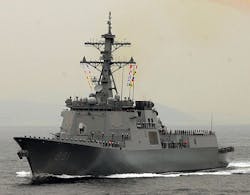Navy chooses shipboard radar power amplifiers from L3 Electron and CPI Beverly Microwave
Officials of the Naval Surface Warfare Center in Crane, Ind., awarded contracts Monday to CPI and L3 Electron Devices potentially worth a cumulative $67.7 million to evaluate, rebuild, and build new power amplifiers for the AN/SPY-1D(V).
Double-duty cross field amplifiers are used on Navy destroyers and Aegis Ashore systems, and by foreign militaries for radar power amplification, Navy officials say.
The contracts are 95 percent for the Navy, 2 percent for Australia, 1 percent for Spain, 1 percent for Japan, and 1 percent for South Korea under the Foreign Military Sales Program.
CPI BMD’s crossed-field amplifiers (CFAs) are broadband, phase-stable microwave amplifiers for coherent radar chains to generate very-high-peak output powers from relatively low input voltages that can be applied either to the cathode or an electrode similar to a traveling wave tube cathode or grid pulsing, and in relatively small, lightweight packages, CPI officials say.
These characteristics make CFAs particularly well-suited for applications in which the transmitter must be either airborne, transportable, mobile, or portable.
CFAs most often are used as high-power stages in master oscillator power-amplifier systems in which either frequency or phase information must be processed. They can also be used as simple power boosters, increasing the output of systems using magnetron oscillators.
Related: ITT Exelis to help Navy with new EW system to protect ships from recently discovered threat
The AN/SPY-1 radar is a passive electronically scanned system for the Aegis combat system. The system is computer controlled, using four complementary antennas to provide 360-degree coverage. The system has been in service since 1983 on Navy Ticonderoga-class cruisers and Arleigh Burke-class destroyers.
The AN/SPY-1D(V) version is a littoral warfare radar upgrade to the -1D variant on Flight IIA Burke-class destroyers, as well as for Japanese navy Atago-class destroyers, South Korean King Sejong the Great-class destroyers, and Spanish F-105 frigates.
On this contract CPI and L3 will do the work in Beverly, Mass., and Williamsport, Pa., and should be finished by March 2019.
For more information contact Communications & Power Industries online at www.cpii.com, L3 Communications Electron Devices at www2.l-3com.com/edd, or the Naval Surface Warfare Center-Crane at www.navsea.navy.mil/nswc/crane.

